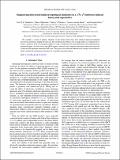| dc.contributor.author | Venderbos, Jorn W. F. | |
| dc.contributor.author | Manzardo, Marco | |
| dc.contributor.author | Efremov, Dmitry V. | |
| dc.contributor.author | van den Brink, Jeroen | |
| dc.contributor.author | Ortix, Carmine | |
| dc.date.accessioned | 2016-02-02T15:21:37Z | |
| dc.date.available | 2016-02-02T15:21:37Z | |
| dc.date.issued | 2016-01 | |
| dc.date.submitted | 2016-01 | |
| dc.identifier.issn | 1098-0121 | |
| dc.identifier.issn | 1550-235X | |
| dc.identifier.uri | http://hdl.handle.net/1721.1/101071 | |
| dc.description.abstract | We consider a system of spinless fermions on the honeycomb lattice with substrate-induced modulated electrostatic potentials tripling the unit cell. The resulting non-Abelian SU(2) gauge fields act cooperatively to realize a quadratic band crossing point (QBCP). Using a combination of mean-field theory and renormalization group techniques, we show that in the QBCP regime, arbitrarily weak repulsive electronic interactions drive the system into the quantum anomalous Hall state. This proves that substrate-induced local voltages are an effective knob to induce the spontaneous formation of a topological quantum phase. | en_US |
| dc.description.sponsorship | Deutsche Forschungsgemeinschaft (Grant OR 404/1-1) | en_US |
| dc.description.sponsorship | Deutsche Forschungsgemeinschaft (Grant SFB 1143) | en_US |
| dc.publisher | American Physical Society | en_US |
| dc.relation.isversionof | http://dx.doi.org/10.1103/PhysRevB.93.045428 | en_US |
| dc.rights | Article is made available in accordance with the publisher's policy and may be subject to US copyright law. Please refer to the publisher's site for terms of use. | en_US |
| dc.source | American Physical Society | en_US |
| dc.title | Engineering interaction-induced topological insulators in a √3 × √3 substrate-induced honeycomb superlattice | en_US |
| dc.type | Article | en_US |
| dc.identifier.citation | Venderbos, Jorn W. F., Marco Manzardo, Dmitry V. Efremov, Jeroen van den Brink, and Carmine Ortix. "Engineering interaction-induced topological insulators in a √3 × √3 substrate-induced honeycomb superlattice." Phys. Rev. B 93, 045428 (January 2016). © 2016 American Physical Society | en_US |
| dc.contributor.department | Massachusetts Institute of Technology. Department of Physics | en_US |
| dc.contributor.mitauthor | Venderbos, Jorn W. F. | en_US |
| dc.relation.journal | Physical Review B | en_US |
| dc.eprint.version | Final published version | en_US |
| dc.type.uri | http://purl.org/eprint/type/JournalArticle | en_US |
| eprint.status | http://purl.org/eprint/status/PeerReviewed | en_US |
| dc.date.updated | 2016-01-27T23:00:08Z | |
| dc.language.rfc3066 | en | |
| dc.rights.holder | American Physical Society | |
| dspace.orderedauthors | Venderbos, Jorn W. F.; Manzardo, Marco; Efremov, Dmitry V.; van den Brink, Jeroen; Ortix, Carmine | en_US |
| dc.identifier.orcid | https://orcid.org/0000-0002-0543-6298 | |
| mit.license | PUBLISHER_POLICY | en_US |
| mit.metadata.status | Complete | |
